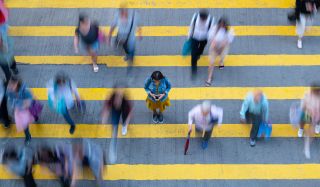Schadenfreude
Community Is the Opposite of Schadenfreude
Rethinking the meaning of connectedness in the age of social media.
Posted July 12, 2023 Reviewed by Davia Sills
Key points
- Connectivity is not the same as community.
- The experience of community requires empathy and recognizing that humans live in a web of mutuality.
- In the age of social media, people must foster feelings of solidarity, respect, and appreciation for others.

Next year will mark 20 years since the founding of Facebook. In a retrospective interview in 2016, co-founder and CEO Mark Zuckerberg recalled the happiness he felt on the day in 2004 when the website was launched for Harvard students: “Now our community can be connected,” he told a classmate. “But one day, someone is going to build this for the whole world.”
Zuckerberg wasn’t alone in those hopeful sentiments. In the early years of social media, a spate of bestselling books and media commentary heralded a new age of unprecedented community. People could connect across any distance, share their views and life updates, and form groups based on common interests, from climate activism to arthouse cinema to skydiving.
In 2006, Time Magazine’s selection for Person of the Year was “You”—a commentary on the power of social media to empower us to authentically express ourselves, to understand others across cultural contexts, and to build community with anyone we choose. The thinking, back then, wasn’t just that social media would mean a more connected society. It would mean a more compassionate society.
Looking back, it’s true that social media platforms like Facebook and Twitter have enabled people to share their personal stories in ways that have launched tidal waves of social change—as with the Arab Spring and #MeToo. Social media has, at times, facilitated life-saving forms of connectedness like mutual aid societies during COVID lockdowns and safety check-ins during emergencies.
Still, looking back at the hopefulness of those early days of social networking, it’s clear that we’re now reckoning with a simple truth: Connectivity is not the same as community.
According to the latest UN estimates, more than 60 percent of people globally now have Internet access. Ninety-seven percent of teens in the U.S. use the Internet every day, and nearly half use social media “almost constantly.”
Yet the U.S. Surgeon General just declared an “epidemic of loneliness and isolation”—and put forth a health advisory of the sort usually reserved for issues like smoking or obesity. In South Korea, the government announced in April that it would begin paying young people $500 a month to leave their homes and re-engage with society. In the UK—where the government has appointed an official lead on loneliness issues and appropriated more than £30 million to address the challenge—the total number of people who say they “often” or “always” feel lonely increased from 2.6 million people in 2020 to 3.3 million people in 2022.
How can we have so much connectivity and such a deficit of community?
Over the course of more than 150 conversations with leaders and experts across diverse sectors, I’ve come to an understanding that belonging—the ultimate basis of community—requires connection not only in terms of the kind of human contact we can make on a screen, but also in deeper ways: sharing the experience of living together in a physical place, connecting through common purpose, and forging a unified sense of meaning and belief.
As much as anything, the experience of community requires wishing well for other people and recognizing that we ultimately live together in a web of mutuality.
In recent years, a once-obscure, hard-to-pronounce psychological term from the German language has come into the popular lexicon: Schadenfreude. You see it in articles about celebrities’ marital troubles and politicians’ legal woes. It’s a term that means the experience of joy that comes from witnessing the troubles, failures, or humiliation of others.
Schadenfreude is, in effect, the antithesis of community.
And social media has created the conditions for schadenfreude to run rampant.
Social media vastly amplifies our exposure to other people’s lives—particularly carefully curated highs rather than lows—in ways that can increase feelings of comparison, competition, and envy. A 2022 study published in the Journal of Personality and Social Psychology found that comparisons with people perceived as successful were more likely to provoke schadenfreude than joy. The distance and relative anonymity of online life make people less likely to feel empathy than in face-to-face situations—a factor leading to high rates of mistrust of other people and institutions these days.
Today, in an age when people are often confined to ideological echo chambers on social networks, many increasingly feel negatively toward individuals outside their world views or ideological cliques. When someone with different values or ideas is shamed or humiliated online, it might simply look like justice is being served.
Social researchers have, counterintuitively, identified schadenfreude as a certain kind of “social glue”—because delighting in the misfortune of a vilified public figure or politician can bring like-minded people closer together. But this isn’t the basis of a genuine community. It’s an example of what I’ve come to identify in my research as “the shadow side of belonging”—a false feeling of community with some people based on the exclusion and ostracizing of some “other.”
To truly build belonging in the age of social media, we have to do more than boost connectivity. We also have to foster feelings of solidarity, respect, and appreciation for other people.
We can start with our own personal practices. In Buddhist psychology, there’s a concept called Muditā, which, in the Pali language, means “Sympathetic Joy.” A longstanding element of mindfulness practice is to focus consciously on having positive reactions at the thought of good things happening to other people—including not only people we love but also people for whom we feel neutral or difficult emotions. Likewise, according to growing scientific literature on mindfulness, practices for cultivating gratitude and self-compassion can increase our levels of empathy.
We can also reverse schadenfreude by engaging in the kind of human connection that screen time—by definition—doesn’t afford. In an article published in 2021 in the journal NeuroImage, researchers reported that deliberately locking eyes with another person can make you more likely to feel genuine happiness when they share good news.
Of course, we can’t simply put all the onus on individual changes in behavior. The new U.S. Surgeon General’s recent advisory on loneliness and isolation lays out a series of recommendations for social media and technology companies, including more transparency with their research on the psychological impacts of their products, as well as more conscious efforts to avoid “design features and algorithms that drive division, polarization, interpersonal conflict, and contribute to unhealthy perceptions of one’s self and one’s relationships.” If social media companies want to make good on the promise of community and compassion, then it’s important to prioritize these values rather than solely focusing on the maximization of advertising revenue and profit to shareholders.
As political leaders start to take issues of belonging and isolation more seriously, it’s important to go beyond the standard solutions, like loneliness awareness campaigns and checklists for the medical system. While these strategies can be helpful, the government needs to be creative and develop a more nuanced understanding of what it means to build belonging.
Programs that boost volunteerism are a good start because they build not only social bonds but also empathy. Less-recognized approaches, like Mindfulness-Based Stress Reduction programs in schools, clinics, and prisons, can likewise help reduce the culture of schadenfreude. Policymakers need to remember that the key isn’t just to increase connectivity. It’s to inspire a shift in values toward freudenfreude—a German word that means the opposite of schadenfreude or the happiness that comes with witnessing the well-being of others.
The vision of social media connecting the world in the warmth of community hasn’t come to pass. But this doesn’t mean that humanity is incapable of creating a more profound connection. People today are longing for belonging. People are motivated to find solutions. That means building not just connectivity but the experience of joy in one another.




